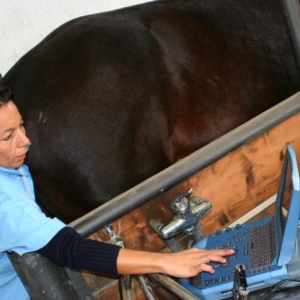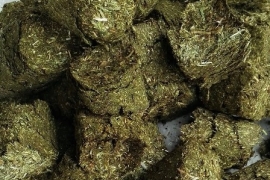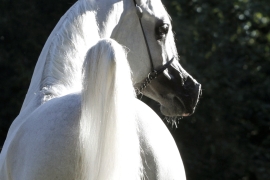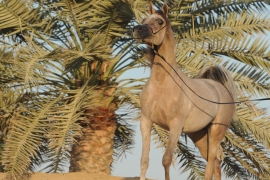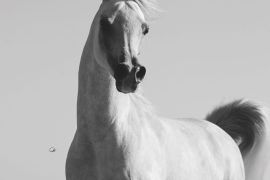Cerebellar Abiotrophy
Cerebellar abiotrophy (CA), also referred to as Cerebellar Cortical Abiotrophy (CCA), is a genetic neurological disease in animals best known to affect the Arabian horse and over a dozen breeds of dog. In addition to dogs and horses, there also have been cases of cerebellar abiotrophy in Siamese and Domestic Shorthair cats; in Angus, Polled Hereford, Charolais and Holstein Friesian cattle; Merino and Wiltshire sheep; and Yorkshire pigs
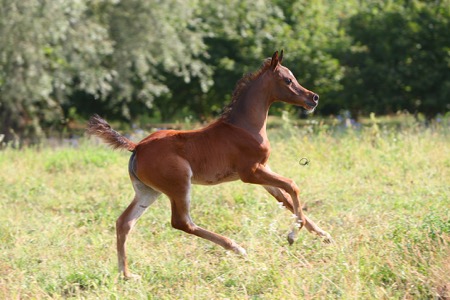
CA is believed to follow a monogenic autosomal recessive inheritance. A perfectly healthy mare or a stallion carry only one copy of the allele and may pass it on to their offspring. If both parents carry the mutant allele to the newformed embryo, then the pathology is expressed fenotipically and the clinical signs of the diseases appear few weeks after the foal birth.
CA cannot be prevented, other than by selective breeding to avoid the concurrence of two alleles for CA, and it cannot be cured. In horses, the condition is most commonly seen in Arabian and part-Arabians, but a few cases have been observed in the Miniature Horse, the Gotland Pony, and possibly the Oldenburg. Most foals appear normal at birth, with clinical signs noticeable at an average age of four months, though there have been cases where the condition is first seen shortly after birth and other cases where the onset is gradual and clinical signs are first recognized in horses over one year of age. 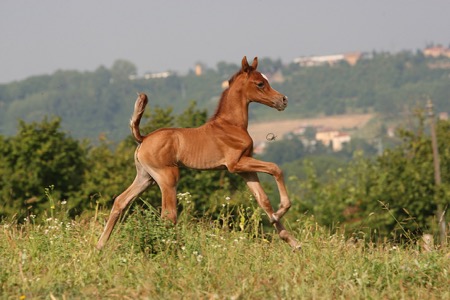
The condition develops when a set of neurons located in the cerebellum of the brain, known as Purkinje cells, begin to degenerate. These cells affect balance and coordination. They have a critical role to play in the brain in that they allow communication between the inner and the out part of the cerebellum. When they degenerate, the loss of communication in this organ balance and coordination get difficult and the animal loses its sense of space and distance.
Cerebellar Abiotrophy in horses was originally thought to be a form of cerebellar hypoplasia, a condition where the Purkinje cells fail to develop in the embryo before the animal is born, and cases were described as such in older research literature. However, it was discovered that in horses, the decline of Purkinje cells usually began after the animal was born.
CLINICAL SIGNS
Clinical signs of CA are, when taken as a group, fairly unique and not easily mimicked by other illnesses, though certain types of neurological injury and inflammation due to infection do need to be ruled out. Though distinguishable from other neurological conditions, many local veterinarians have never seen a case, or are not familiar with the clinical signs, and thus CA has been confused with Wobbler's syndrome, Equine Protozoal Myeloencephalitis (EPM), and head injury.
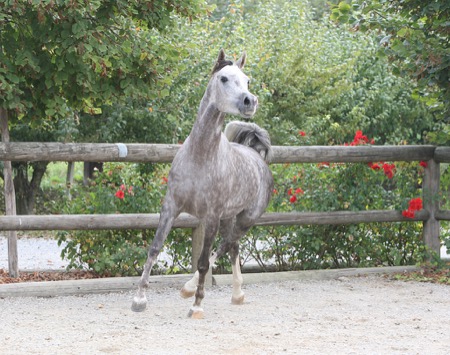
However, the combination of clinical signs and lack of neurological damage to other areas of the brain or spine is sufficiently unique that CA can be clearly distinguished from other neurological problems in a living animal.
Unfortunately the diagnosis can be verified only by examining the brain post-mortem to determine if there has been a loss of Purkinje cells.
Signs may worsen from the time of onset for six to 12 months, but if not severe enough to mandate euthanasia, they gradually stabilize over a period of one or two years. Most affected animals have normal intelligence and mildly affected animals can, in theory, live out a normal lifespan. However, they are quite accident-prone. Horses may experience difficulty stepping up and over objects, run into fences, fall easily, and even if allowed to mature to full growth, are generally considered unsafe to ride. Thus, many horses that develop CA are euthanized for humane reasons. There is anecdotal evidence that affected animals partially compensate for the condition by cognitively learning alternative methods for moving or to determine distance. Thus, they appear to improve because they become less accident-prone and may learn to control levels of activity when anxious.
Clinical signs include ataxia or lack of balance, an awkward wide-legged stance, a head tremor (intention tremor), hyperreactivity, lack of menace reflex or blink response, a stiff, excessively high-stepping gait in the forelimbs known as hypermetric action, a stiff, abrupt, bursty quality of the gait in all limbs, coarse or jerky head bob when in motion (or in very young animals, when attempting to nurse, known as intention tremor), apparent lack of awareness of where the feet are (sometimes standing or trying to walk with a foot knuckled over), poor depth perception, and a general inability to determine space and distance. There is a marked tendency to rear up and occasionally fall over backwards when a handler reaches for the halter or pulls abruptly on a lead shank. Clinical signs of CA may become exacerbated when the horse is excited.
IMAGES BELOW ARE ATTACHED IN CONTRAST EXPLANATORY OF THE POST MORTEM DIAGNOSIS
Normal Cerebellum - LEFT
The normal cerebellum is divided into two layers: the inner layer, known as the granular layer, and the outer layer, known as the molecular layer. Purkinje cells are large neurons that lie on the border between these two layers. They carry electrical signals from the molecular to the granular layer, where the signal is then transmitted to the body. They carry all messages generated by the cerebellum and have control over the refinement of movement and coordination.

Cerebellum affected with CA - RIGHT
In horses affected with CA, the Purkinje cells begin to degenerate soon after birth. Purkinje cells are closely associated with the granular cells in the cerebellum and their death causes a subsequent loss of granular cells as well. Remaining Purkinje cells are usually small and shrunken. Without the Purkinje cells, the two layers of the cerebellum become indistinct. This image was taken of the cerebellum of a 3-year-old Arabian colt affected with the disease.
WHAT CAN BE DONE?
There currently is no DNA test for CA. However research is taking place at the Veterinary Genetics Laboratory at the UC Davis School of Veterinary Medicine, http://www.vgl.ucdavis.edu
Testing is also being done at the Dr. van Haeringen Laboratorium b.v in the Netherlands and the Tierärztliche Hochschule, Hannover, Germany,by Prof. Dr. O. Distl; and that the CA website maintains a list of publically disclosed CA Status Results and has an easy to fill-in submission form on line.
The Cerebellar Abiotrophy website has a great deal of useful information - http://www.cerebellar-abiotrophy.org
Please visit this site for further information and details about CA and the newly available indirect genetic test.
For further information on CA therefore please contact the site and/or organizations mentionned above.

